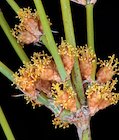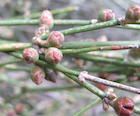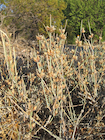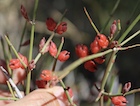
Active male strobili on a plant in habitat, Texas; iNaturalist observation 517846 [Richard Reynolds, 2010.03.22]

A plant in habitat, Texas; iNaturalist observation 628980 [Kenneth Bader, 2014.04.12]

Immature female strobili on a plant in habitat near the eastern limit of the species, Texas; iNaturalist observation 19147819 [Chuck Sexton, 2010.04.05]

Female strobili on a plant in habitat, New Mexico; iNaturalist observation 2400666 [Ellen Hildebrandt, 2013.05]

Fruits on a plant in habitat, Texas; iNaturalist observation 24568315 [Lena Zappia, 2019.04.21]

Ephedra antisyphilitica
Berlandier ex C.A. Meyer 1846
Common names
Clap-weed, popote, tepopote, Cañatilla (Torrey 1858, Stevenson 1993).
Taxonomic notes
Syn: Ephedra antisyphilitica var. brachycarpa Cory 1938; E. occidentalis Torrey ex Parlatore 1869; E. texana E.L. Reed 1935 (Stevenson 1993).
Description
Shrubs, erect or spreading, up to 1 m tall. Bark gray, slightly cracked and irregularly fissured. Branches alternate or whorled, rigid, angle of divergence about 45°. Twigs green, becoming yellow-green with age, glaucous, not viscid, with numerous longitudinal grooves; internodes 2-5 cm. Terminal buds conic, 1-3 mm, apex obtuse. Leaves opposite, 1-3 mm, connate to 2/3-7/8 their length; bases thickened, brown, completely deciduous; apex obtuse. Pollen cones 1-2 at node, lance-ellipsoid, 5-8 mm, sessile to nearly sessile; bracts opposite, 5-8 pairs, pale green to red, obovate, 2-4 × 2-3 mm, membranous, connate at base; bracteoles slightly exceeding bracts; sporangiophores 4-5 mm, 1/2 exserted, with 4-6 sessile to very short-stalked (less than 1 mm) microsporangia. Seed cones 1-2 at nodes, ellipsoid, 6-12 mm, sessile to nearly sessile; bracts opposite, 4-6 pairs, ovate, 5-7 × 5-10 mm, connate to 1/8-7/8 their length, inner pairs becoming fleshy and red. Seeds 1(-2), ellipsoid, 6-9 × 2-4 mm, light brown to chestnut, smooth. Cones fertile March-April (Stevenson 1993). Note that this and E. pedunculata are the only North American Ephedra with fleshy, red seed cones.
Stevenson (1993) provides this Key to the North American species of Ephedra.
Distribution and Ecology
US: Oklahoma and Texas; Mexico: Nuevo León and San Luis Potosí; at 100-1200 m on dry soils and rocky slopes. "Mexican populations ... are disjunct from those in Texas." (Stevenson 1993).
Remarkable Specimens
No data as of 2023.03.03.
Ethnobotany
Torrey (1858) says "the Mexicans ... use a decoction of it as a remedy for gonorrhea."
Observations
Remarks
The epithet antisyphilitica is a reference to the plant's use as a treatment for venereal disease (Torroy 1858).
Citations
Meyer, C. A. 1846. Versuch einer Monographie der Gattung Ephedra, dirch Abbildung erlautert. Mémoires de l'Académie impériale des sciences de St.-Pétersbourg, Sér. 6, Sci. Math., Seconde Pt. Sci. Nat. 5:35-107. Available: Biodiversity Heritage Library, accessed 2021.12.26.
Torrey, J. 1858. Botany of the boundary. In W.H. Emory, Report on the United States and Mexican Boundary Survey, Vol. 2, Part 2. Washington, D.C.: A. O. P. Nicholson. Available: Biodiversity Heritage Library, accessed 2021.12.26.
See also
Species profile at Plants of the World Online, accessed 2021.12.29.





